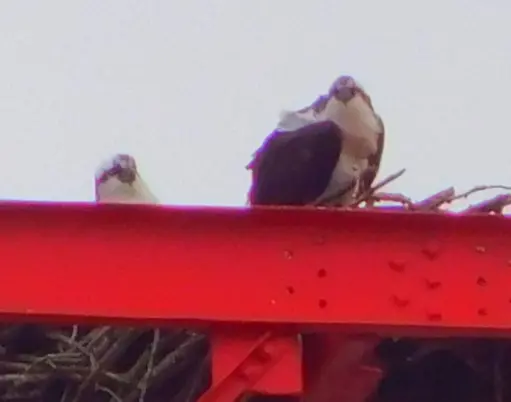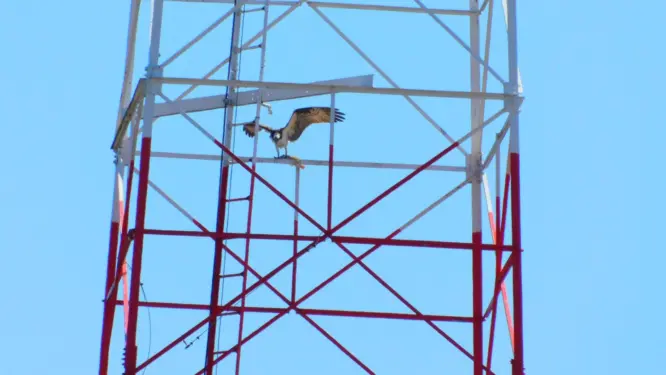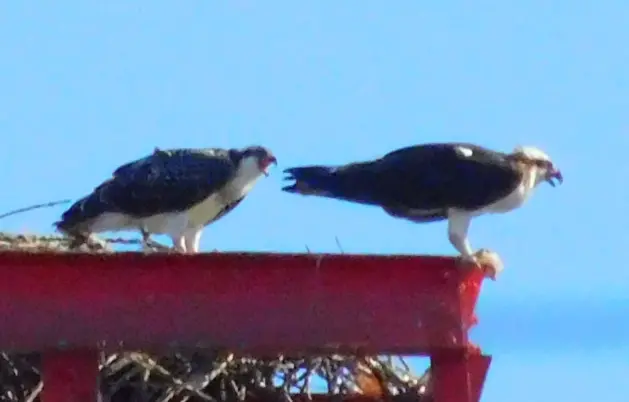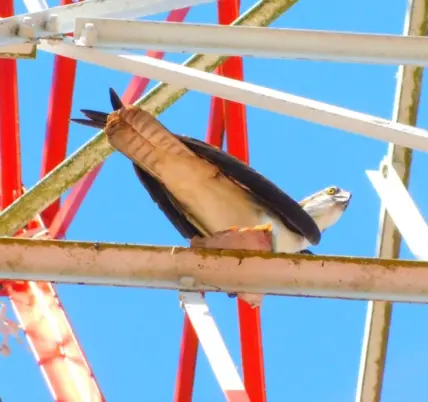Return of the Osprey

Sovereignty of Nature: The CPTC Osprey
“I think he’ll be to Rome as is the osprey to the fish, who takes it by sovereignty of nature.”
by Marcia Wilson
In English, a flock of birds can have different names. A plurality of hawks is called a cast. A group of robins are a blush or carol. Jays travel in parties or bands. The rule of naming is normally based on a reliable behavior for these birds when they are in a social setting.
But the magnificent osprey that fly to the Lakewood campus every spring do not travel in groups and they are not social. They are solitary by nature, and only stay together in short-lived family units that begin in the spring and end in late summer. For this reason, the plurality for osprey is a duet. Now that they have returned to their longtime nesting site on the Lakewood radio tower, our resident duet is hard at work repairing the winter’s damage to their old nest.
The birds are large with a 5.5-foot long wingspan (1.67 meters) which is slightly under the size of a bald eagle. They are dramatic subjects for any photographer, and many bird lovers know to come watch them on campus or at their favorite fishing-holes across the street in the marshlands. Elegant and powerful, the birds inspire admiration, such as in the Seattle Seahawks–a name and mascot that was voted in high majority in 1975. The osprey on campus have a large following of fans who regret their departure in the cold months, and wait hopefully for their return in April.
Meeting the Family
Birds are typically identified with the males being larger and more colorful than the females of their species. Ospreys are an exception to the rule: males have white chests, briskets and bellies. The females are about one-third larger and have a speckling of toast to russet brown feathers in a “necklace” pattern.
The female’s larger size is necessary. She protects the nest. The male has the job of hunting fresh fish for them all. This is exhaustive work and he has little energy to spare. Bald eagles are a common aggressor. One spring, a bald eagle tried very hard to rob the CPTC nest but the parents objected so strongly with an aerial attack that witnesses likened it to “a WWI dogfight.” The eagle fled and was later seen noshing on roadkill opossum behind the CPTC warehouse.

Mexico to Rest, Lakewood to Nest
Ospreys are large birds and thus have a long breeding cycle. This forces them to adapt in ways unique to their species. In some parts of North America, they are one of the first returning migrants. In the Pacific Northwest, they are not the earliest of birds, but their arrival roughly coincides with the departure of winter residents, such as cackling geese and Northern Shovelers. The female shows up first to start on the nest and if her mate takes too long to join her or fails to arrive, she accepts another helpmeet. There simply isn’t time to delay. Long, loud peeping, chirping and calling sounds can be heard as far away as Building 23 when the birds get a good conversation going. Osprey keep their “talking” down to communications between mates, their chicks, and threats to enemies.
Summertime
An old name for osprey is “fishing hawk” and here, the ospreys really come into the name. A volunteer birdwatcher in the college wetlands confessed to being startled by a gigantic BANG of bird hitting the water and coming back up with a fat fish in its talons when she least expected it. Osprey have to be careful when they strike because their oversize feet could get caught on something. This is the easiest time to get food; warm weather brings fish to the surface of the water. In unseasonal cold spells the fish will stay deep, and chicks can be lost to hunger.
Early Fall to Winter

Now that the chicks are the size of large chickens and covered with speckled adult feathers, the female can take a rest. She does this by flying back to Mexico, before the waters of Flett Creek cool off. The father stays behind to teach the young how to catch their own fish. He will do this by eating fish, just far enough away that the chicks will leave the nest to follow him. Warm days are the best for finding food. In Summer Quarter, it is not unusual to see a large flatfish hanging over the radio tower. Other fish seen are salmon, occasional trout, and a great deal of non-native catfish. Crows and other scavengers do an excellent job of cleaning up the litter the osprey may leave behind. By the end of fall, most of the osprey will be long gone, but last year, a juvenile male chose to stay on campus a few weeks longer.
Next Year?

Wild ospreys have a lifespan of about 7-10 years. Eventually, the CPTC seahawks will be replaced by other osprey–perhaps their own offspring. As long as there are plenty of fishing spots and a good, safe radio tower for their nest, they have no wish to leave.
With their soaring flights over campus, loud peeping that can be heard everywhere, and propensity for dropping fish around Building 11, the CPTC osprey are messy but welcome heralds of spring.